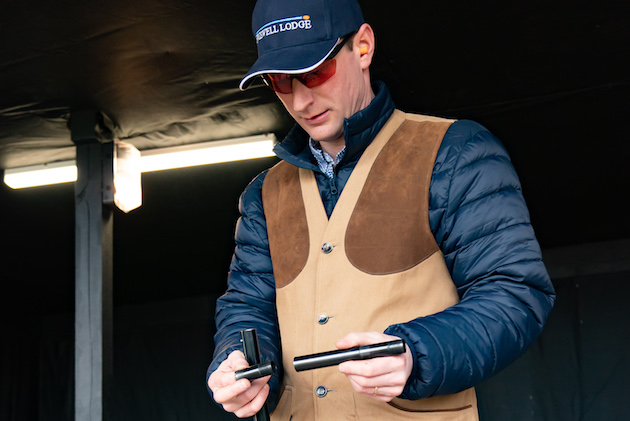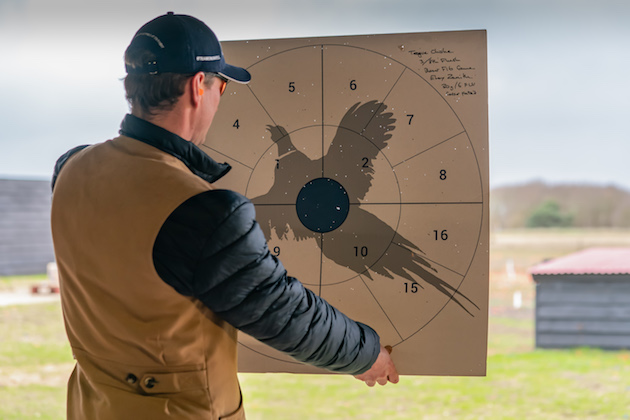How to choose a practical choke
Why your shooting success, whether driven, flighted, decoyed or walked-up, depends on the choke you use
Win CENS ProFlex DX5 earplugs worth £1,149 – enter here
 Simon fitting a choke
Usd 27 march 19 chokes
Simon fitting a choke
Usd 27 march 19 chokes
The degree of choke in your gun barrel is the difference between the size of the bore — the barrel diameter — relative to the constriction at the muzzle. For this reason, plug-in choke “gauges” will only ever give you a very rough guide. The only way to measure choke accurately is with a bore gauge of the type gunsmiths use to measure bore diameter when checking if a gun is in proof.
When buying secondhand guns, if a barrel has had any pits bored out of it and been reproofed as a result, this will alter the choke measurement without the shotgun chokes themselves being changed. The relationship between barrel and muzzle is one that matters.
Choke itself is measured in thousandths of an inch usually up to 40 thousandths. Every five thousandths of an inch is one point of choke. Normal chokes are given in eighths. Twenty thousandths of an inch between muzzle diameter and barrel diameter would therefore be 20/40, four-eighths or half choke. I prefer to measure in eighths.
The technical aspects aside, the question before us is, does choke matter? The answer is, up to a point, yes. It is down to you to find out what particular combination works for you but you must use a pattern plate. BASC has an excellent information sheet on how to pattern-test properly but it is vital to use at least 10 cartridges through the same gun and choke to gather a big enough sample. It might surprise you what more open chokes are capable of. You may be shocked at how large gaps can appear in some extremely tight chokes too.
Multichokes for double-barrelled shotguns are relatively new. The first was the Winchoke, which was introduced by Winchester in 1969. Multichokes have now become commonplace and companies such as Teague Chokes will retrofit multichokes to any gun. The benefit of Teague’s thin-walled chokes is they do not alter the balance of the gun.

It is vital to use a pattern plate to determine what combination of choke works for you
Some guns have the option of a multichoke or a fixed-choke version. Factory multichokes can feel muzzle-heavy compared with the fixed- choke versions, as factory screw-in chokes tend to be much thicker steel lying at one end of a fulcrum, like a heavy weight on a seesaw. The great benefit of the development of the multichoke is that it became much more adaptable and Sporting clay shooters could change it according to the targets they were facing.
But agonising over the best choke for a particular target can lead to indecision and distraction when you should just get on and shoot the bird. The best performers, both clay and game, understand that reducing the variables in the recipe can help with the all-important ingredient for good shooting — confidence.
One of the very best, Olympic gold medallist Richard Faulds, said: “Personally, I’ve used Express cartridges and full- and full-choke for over 20 years now, but to be honest, when you compare the breaks that Tanya [Faulds] gets with improved cylinder [one-eighth] that she uses all the time, you can hardly tell the difference. It’s all down to confidence and what works for you.”
Choke certainly does matter when using steel shot for shooting wildfowl. Again, BASC’s guidance sheets are invaluable. You should not use high-performance steel wildfowling loads in tighter than half-choke. Steel pellets are harder than lead and they do not deform when passing through a constriction. Because of this, ring bulges can occur if too tight a choke is used with large steel pellets. Shotguns rarely blow up but bulges can ruin the performance and value of a gun.

Choke is an even greater consideration for wildfowlers who are using steel shot
There have always been arguments as to whether fibre wads throw more open patterns than plastic wads, but there are simply too many variables in the equation: barrel maker, length of forcing cone, bore diameter, choke profile and degree of choke. Then you have to add the range of component parts that cartridge manufacturers use in their own products.
My own experience tells me that budget fibre-wad cartridges may well benefit from the use of a slightly tighter choke in the same way that top-of-the-range clay cartridges, almost all of which are plastic wadded, may well throw tighter patterns than you might expect. The difference is only really noticeable on the most testing of clay targets, but may well separate the podium positions.
Consumers like choice and manufacturers understand this. What we have to do as shooters is benefit from the experience of seasoned Shots, both clay and game, most of whom find a combination they have full confidence in and stick with it. That confidence can only be gained by finding out exactly what your chosen combination is doing by using a pattern plate. Shooting takes an enormously complicated calculation: trying to hit a target 40 yards away, doing 40mph, with a moving gun, throwing a shot column at 900mph. When broken down like this, it is a wonder we ever hit anything. The US military had serious problems trying to get a missile protection system to replicate this calculation.
Why your shooting success, whether driven, flighted, decoyed or walked-up, depends on the choke you use
First, what is a shotgun choke? Choke is a narrowing or constriction at the muzzle end of the barrels that…
The trick is to simplify it as much as possible. This then allows nature’s most astonishing computer — your brain — to do the maths for you. When you remove as many variables as possible from the equation you can’t blame the equipment when you miss — it was working for you last week after all. Using a consistent recipe means you are far more likely to solve the problem by looking to your footwork, gun-mount, timing and relaxation. The problem almost always lies in one of these areas.
Does choke matter? As we have seen it is more complicated than that. Once you have found a combination you have confidence in, stick with it and leave the chokes alone.
Get the latest news delivered direct to your door
Discover the ultimate companion for field sports enthusiasts with Shooting Times & Country Magazine, the UK’s leading weekly publication that has been at the forefront of shooting culture since 1882. Subscribers gain access to expert tips, comprehensive gear reviews, seasonal advice and a vibrant community of like-minded shooters.
Save on shop price when you subscribe with weekly issues featuring in-depth articles on gundog training, exclusive member offers and access to the digital back issue library. A Shooting Times & Country subscription is more than a magazine, don’t just read about the countryside; immerse yourself in its most authoritative and engaging publication.

